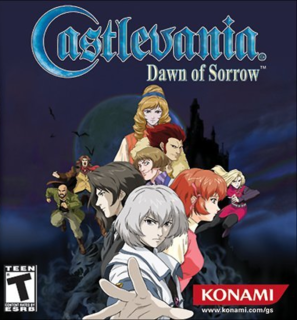“Dawn of Sorrow” is the perfect example of why we associate the “Castlevania” name with grandeur.
As with all “Castlevania” titles, Dracula’s castle has resurfaced but this time without the actual Dark Lord. Soma Cruz, the protagonist from the last game, is targeted by a cult led by the aggressive Celia who deems Cruz as the Lord of Darkness destined to rule the Dracula-less castle. Denying Celia, Cruz finds out (yet again) that he has unusual powers for a human and follows her into the castle to prove once and for all that he is in fact, not the usurper of Dracula.
Tried and true, the “Castlevania” story hardly differs from previous titles and follows the standard ‘vania motto; enter, purge evil, leave. Even still, “Dawn of Sorrow” manages to add in some twists that spin the story in a positively new direction. It may not revitalize the stereotypical nature of the “Castlevania” cliché but it truly doesn’t matter. The story is as deep as it needs to be and leaves no sense of disappointment by the time the end comes.
Being the first “Castlevania” game to debut on the DS, the series has never looked better. The anime-esque graphics appear sharp, animations are smooth, and the monster models look detailed and intimidating. Throughout the course of the game you’ll fight well over a hundred enemies. While there are plenty of new and unique monsters to face, a lot of the models are recycled directly from previous games. Thankfully the responsive controls and addictive gameplay erase the thoughts from your mind. But with virtually no changes made ‘vania veterans will take notice.
“Aria of Sorrow’s” soul collection feature makes a welcome return with a few enhancements. As with the previous system there are three types of souls, bullet (offensive), guardian (defensive), and passive. When you destroy any enemy they have a chance of giving you their soul to utilize. “Dawn of Sorrow” allows you to stack up to nine souls of the same enemy, only this time each additional soul increases the power of the corresponding ability. Hording souls works but you also have the option to release certain ones into your weapons effectively upgrading them to the next level. There are even some souls that work in tandem with one another, acting as a team but only if they are all equipped at the same time.
If you couldn’t tell, souls are the bread and butter of “Dawn of Sorrow” and there’s a metric ton of them. Some return from “Aria of Sorrow” but most are new or have been altered to do a more effective, flashy ability. There are few that are utterly useless and some that are ridiculously powerful but with over a hundred abilities to choose from you’ll be hard-pressed to find anything to complain about. Add the ability to alter your weapons through a blacksmith-like soul forge, team up specific abilities, plus power stack certain souls and you’ve got a full-fledged arsenal of hurt to unleash upon the undead.
The DS’s touch-screen is a feature that Konami unfortunately did very little with. After you defeat a boss, the screen prompts you to draw a certain pattern to “seal” the boss away. If you fail to draw the correct pattern the boss regains some health and the battle resumes. While a neat idea, it’s not particularly challenging and happens just a dozen or so times. The only other time the stylus is used is in conjunction with the Balore soul. It allows you to break ice blocks by touching the screen, however these certain blocks are found only in two areas of the entire game. These touch features are fun and they add to the inventive nature of the game albeit how small they actually are.
Along with the compelling gameplay, the music is arguably one of “Dawn of Sorrow’s” best and most memorable features. It’s the sort of soundtrack that you hum to yourself when you’re doing mundane tasks like waiting for the bus. Songs like “Demon Castle Pinnacle” will never leave your head, ever. Not to mention, Konami has cleverly “revamped” some old school ‘vania tunes that veterans will instantly recognize. There hasn’t been a more memorable soundtrack since “Symphony of the Night” but “Dawn of Sorrow” bests it in every way.
Through multiple endings, the game will take anywhere from eight to 13 hours to beat, but rushing through this ‘vania title is a mistake. While most games give you useless unlockables and no reason to explore, “Dawn of Sorrow” does just the opposite. Explore all 100% of the map, collect all the souls, or beat the game on any of its different modes or difficulties and you’ll acquire special items and abilities. Plus after you clear the game for the first time you’ll unlock a boss rush mode and the new Julius mode. Julius mode allows you to play through the game via Julius Belmont with a few guests, one being very special who ‘vania veterans will stammer with glee over. But above all, “Dawn of Sorrow” shows the gaming world how unlockables and replayability should be done.
“Dawn of Sorrow” is the perfect example of why we associate the “Castlevania” name with grandeur. Games packaged with this kind of content and replayability don’t appear often. ‘Vania veterans can rejoice for the crown “Symphony of the Night” entertained all these years has been passed on. Even if you haven’t played any previous “Castlevania” games it’s still an addictive pleasure no action adventure fan should be without.

